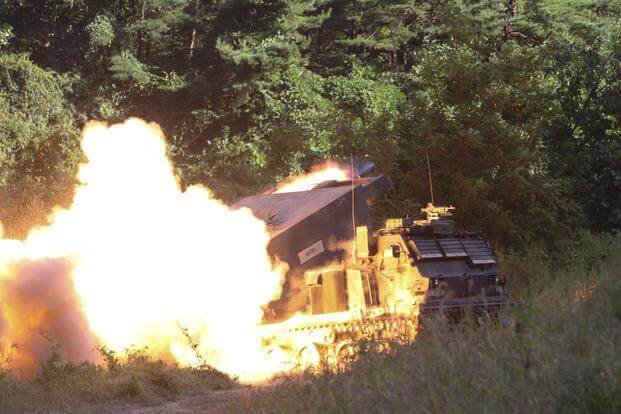The U.S. Army's proposed fiscal 2019 budget would add 4,000 soldiers to the active force and purchase large quantities of long-range missiles and artillery shells.
The service's $182 billion request, including war funding, marks a $13 billion, or 15 percent, increase from its fiscal 2018 request of $169 billion.
With a $148 billion base budget and a $34 billion Overseas Contingency Fund, the fiscal 2019 request improves readiness and restores end-strength and "invests appreciably" in Army modernization efforts, "providing our Army with technological overmatch," Maj. Gen. Paul Chamberlain, director of Army Budget, told reporters at budget briefing Monday at the Pentagon.
The active Army's personnel budget requests $43.7 billion compared to last year's $41.5 billion request. It would boost the number of active-duty soldiers from 483,500 to 487,500. If approved, the 4,000 additional soldiers would be used to resource fires, air defense and logistics units, Chamberlain said.
"The resources applied in this budget for additional end-strength will increase unit readiness levels and support the creation of select units to acquire necessary capabilities taking significant steps toward the Army's warfighting readiness and increasing the Army's capacity for force-on-force decisive action," he said.
The National Guard would hold steady at 443,500 as would the Reserves with 199,500, according to budget documents.
One of the biggest increases in the Army's fiscal 2019 budget request is in the procurement line -- used to buy weapons and munitions -- which is budgeted at nearly $27 billion, an increase of $5.7 billion, or 27 percent, over the current year, according to the documents.
To counter near-peer threats, the request provides "critical munitions for combatant commanders" within the procurement account, said Davis Welch, deputy director of Army Budget. "We are replenishing wartime stocks piles of preferred and advanced munitions to increase lethality," he said.
The request would pay for 148,287 155mm artillery projectiles compared to last year's purchase of 16,573. It also buys 9,450 Guided Multi Launch Rocket Systems compared to last year's purchase of 6,084.
"This is a long-range missile, about 40 miles in range," said David Norquist, comptroller and chief financial advisor for the Office of the Under Secretary of Defense.
"It's useful for the high-end fight when you are dealing not with the assumption of air superiority but when you are trying to suppress the enemy's defenses; you need to be able to reach them from a distance."
The budget request also purchases 404 Army Tactical Missile Systems over last year's 122 -- a 62 percent increase in the ATACMS Service Life Extension program, Welch said.
The spending plan also boosts modernization of armored combat vehicle fleet with an increase of $4.5 billion over last year's $2.4 billion request.
If approved, it would buy 3,990 Joint Light Tactical Vehicles compared to last year's purchase of 2,498.
The request also would buy 197 new Armored Multi-Purpose Vehicles, which are designed to replace the Vietnam War era M113 personnel carriers. Last year's request purchased 107 AMPVs.
The purchase of 135 modernized M1 Abrams tanks over last year's purchase of 56 would feature enhancements such as second generation Forward-Looking Infrared Radar in the gunner's primary sight and a commander's independent thermal viewer, Welch said, adding that at the new Abrams will also have an upgraded armor package and improved engine and transmission.
The budget request cuts aircraft procurement budget to $3.8 billion compared to last year's $4.2 billion request.
This request replaces older UH-60 Black Hawk helicopters with 50 of the latest M model, which offers improved situational awareness and improved rotor blade and engine performance.
The new multi-year build contract "represents a cost avoidance of over $500 million" between FY 2017-2021, Welch said.
Additionally, the request procures seven "special operations" CH-47M Chinook aircraft, which features a more sophisticated avionics package than earlier models, Welch said.
The Army is also requesting $10. 2 billion in RDT&E efforts compared to last year's 9.4 billion request.
It will funding toward programs such as Mobile Protected Firepower, combat vehicle prototyping, long range precision fires and Short Range Air Defense, or M-SHORAD.
The request also realigns $239 million out of the Science and Technology portfolio to support the service's six new modernization priorities -- long-range precision fires, next generation combat vehicle future vertical lift, a mobile and expeditionary network, air and missile defense capabilities and soldier lethality.
-- Matthew Cox can be reached at matthew.cox@military.com.












